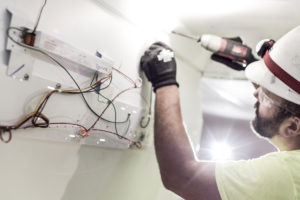10.05.2021
Financial Considerations For Lighting Projects
 Compared to the days of fluorescent retrofits, LED lighting upgrades require a far greater upfront investment of financial resources. The good news is, there are many ways to ease the impact on your business’ budget beyond the reduced monthly utility spend.
Compared to the days of fluorescent retrofits, LED lighting upgrades require a far greater upfront investment of financial resources. The good news is, there are many ways to ease the impact on your business’ budget beyond the reduced monthly utility spend.
The first reduction is through rebate programs such as Wisconsin Focus on Energy (FOE) and is based on the type of solution being installed. For example, for a linear ambient fixture, a lamp replacement will bring in $1.25 per lamp, a new fixture will bring in either $1/foot or $2.50/foot, and if the fixture includes network lighting it will be based on the reduced wattage. If your budget leaves you just shy of being able to afford network lighting, the incentives may help bridge the gap.
Tax credits can also impact project costs quite a bit, depending on what you qualify for. For tax-exempt clients, some lighting designers can apply for tax credits based on the square footage of the areas being upgraded. This can reduce project costs by almost 10%. For-profit companies are able to write off the full interior project costs from their annual taxes. While this isn’t an “instant discount,” it is worth the wait. If your corporate tax rate is 21%, you can plan to receive back 21% of the project costs through the Qualified Improvement Property (QIP) program.
It is also worth considering cost avoidance and maintenance savings — these are the dollars you would have spent on a relamp project (replacement bulbs and installation) or maintaining the current lighting system during the life of the alternative LEDs. Basic fluorescent lamps are rated to last 20-30,000 hours, whereas quality tubular LEDs (TLEDs) will maintain 70% of their output at 50,000 hours. Dedicated LED retrofits or fixtures are built to last with 70% output at 100,000 hours. Without an upgrade, how much of your operating budget will be spent on material costs and equipment rental to access the fixtures? What are the costs for maintenance staff to deal with lighting? Most facilities have more important items their staff could be addressing.
For organizations that still struggle to make the dollars work, consideration can be given to Lighting as a Service (LaaS). In this financial model, the energy savings generated by the upgrade pays for the project costs. For example, instead of monthly payments of $1,000 going to the utility, you pay $400 to the utility and the $600 savings you realize goes toward project costs, similar to a lease. Faith Technologies offers this type of financing option, which can prove to be beneficial in many ways. Because we own the equipment, it is our responsibility to maintain it.
Back when a lighting upgrade meant a more efficient fluorescent system, projects were easily justified by their cost and energy savings. However, with LEDs having a higher initial project cost, be sure to consider the bigger picture as you decide what’s right for your business.
If you enjoyed this blog article, please subscribe to stay up to date on the latest industry news from our experts at Faith Technologies.



